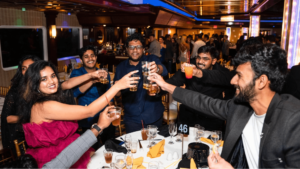If you’ve ever had pre-event anxiety, you know it’s often due to uncertainty over the unexpected. From traffic jams to electrical issues, anticipating problems will help you avoid them. Keep reading to learn how you can avoid logistical snags — and breathe a little more easily.
We sat down with Sharon Sperber, founder of film and food truck festival Eat See Hear. Sperber grew Eat See Hear from the ground up into a festival with thousands of attendees, and nine venues in Los Angeles. Here are Sperber’s top five tips for a successful on-site experience.
- Have a plan A, B, C… and XYZ. As much as you plan, you never know what might happen. From traffic jams to electrical issues, try to anticipate what could happen so that it doesn’t become an issue. For a step-by-step approach to help you plan, check out the complete guide to onsite logistics.
- Be generous with customer refunds. “People sometimes have unrealistic expectations. If and when they complain, it’s absolutely worth giving them a refund,” says Sperber. By treating an upset customer well, you reduce the risk that their negativity will spread – both during and after your event. “A few years ago, an unexpected cloud of june bugs descended on part of our event. Despite the fact that we have entirely no control over nature, we chose to refund any customer that was dissatisfied,” says Sperber. This extra effort goes a long way in preserving your brand.
- Start the paperwork as far in advance as possible. From completing your event paperwork and permits, to securing dates that the venue still has available, everything takes time. In Sperber’s case, there are 85 cities that make up the county of Los Angeles. “Each one of those cities has different requirements, permit processes, and fire marshals,” says Sperber. “Sometimes, when staff in these departments changes, so do the rules. By starting early, you allow yourself extra time to adjust to these changes.”
- Know your key requirements when planning your site map. Every time Sperber lays out a festival, there are certain things that she looks for. “As an outdoor movie event, there’s a really large inflatable screen about 3.5 stories tall and 60 feet wide. We position the screen where the audience can see and hear clearly, from anywhere in the event,” says Sperber. After that, the Eat See Hear team works to figure out where the food trucks, entrance, and generator will go. Once they figure out all the elements of their site map, they can figure out the entry process. At certain venues, they actually rent additional space to accommodate lines.
- Over-communicate. “As much as we put tons of information on our website and on-site, people often don’t read it,” says Sperber. So it’s important to over-communicate, even if it might feel redundant. “I have an autoreply on my email that answers a lot of our most frequent questions. We make sure our vendors have complete information, including where to drive and get set up. We also train our staff in advance on all of our key messages. These include sponsor messages, site activities, what the band is, and more. Finally, at the event, we have clear signage directing each type of ticketholder where to go.”
With the right plan, you can significantly reduce the chance of event mishaps — and put your pre-event mind at ease. For a detailed, step-by-step guide on setting up a complete event logistics strategy, download our full guide here.




